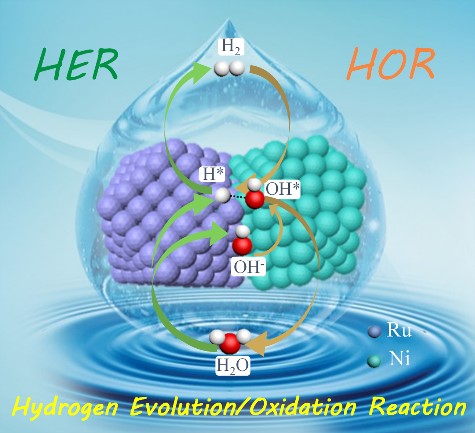Jing Liu a, Jie Wang a, Yumeng Fo b, Boyang Zhang a, Costas Molochas d, Jie Gao a,
Wenzhen Li c, Xuejing Cui a, Xin Zhou*b, Luhua Jiang*a, Panagiotis Tsiakaras*d
a College of Materials Science and Engineering, Qingdao University of Science and Technology,
Qingdao, Shandong 266042, China.
b College of Environment and Chemical Engineering, Dalian University, Dalian, 116622, China.
c Department of Chemical & Biological Engineering, Iowa State University, Ames, IA 50011-1098, United States.
d Laboratory of Alternative Energy Conversion Systems, Department of Mechanical Engineering,
School of Engineering, University of Thessaly, Pedion Areos 38834, Greece.
ABSTRACT: Herein, unique Ni-Ru nano-twins (Ni1Ru1/C) are reported for the first time as a superior bifunctional catalyst for hydrogen oxidation/hydrogen evolution reaction (HOR/HER). Compared to Pt/C, the Ni1Ru1/C nano-twins display a remarkable HOR activity with a comparable mass activity of 0.12Amg-1metal and superior HER activity, with an overpotential (դ) of only 16mV for achieving a cathodic HER current of 10mAcm-2, together with a high turnover-frequency of 1.88s-1 (@դ=30mV). Additionally, the HOR limiting current of the Ni1Ru1/C nano-twins can be maintained up to a break-down potential of 0.25VRHE, demonstrating excellent electrochemical stability. Experimental and theoretical studies reveal that the electron re-distribution at the Ni/Ru interface of Ni-Ru nano-twins optimizes the binding energy of the adsorbed hydrogen (Had) and the adsorbed hydroxyl (OHad) intermediates, allowing the HOR/HER to proceed via a low energy barrier. This work provides a strategy to synthesize hetero-metal nano-twins as promising multi-functional catalysts and highlights the critical role of interfaces for heterostructured electrocatalysts.
Keywords: Ni-Ru nano-twins; hydrogen oxidation reaction; hydrogen evolution reaction; bifunctional catalyst; interface engineering.
*Corresponding authors: luhuajiang@qust.edu.cn (L. Jiang); zhouxin@dlu.edu.cn (X. Zhou); tsiak@uth.gr (P. Tsiakaras).
DOI:10.1016/j.cej.2022.139959



